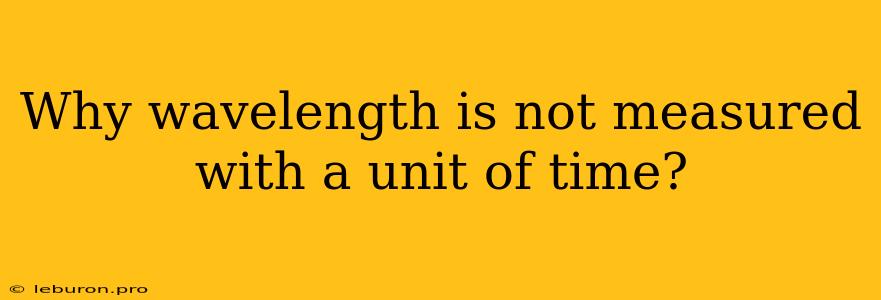The concept of wavelength is fundamentally intertwined with the nature of waves, specifically their spatial characteristics. It represents the distance between two successive crests or troughs of a wave. While time plays a crucial role in describing wave phenomena, it's essential to understand why wavelength is not measured in units of time. To delve into this distinction, we'll explore the nature of waves, the relationship between wavelength and frequency, and the implications of using the wrong units for measuring wavelength.
The Nature of Waves
Waves are disturbances that propagate through a medium or space, transferring energy without transferring matter. They are characterized by their oscillatory motion, exhibiting repeating patterns of crests and troughs. These patterns are described by various parameters, including:
- Amplitude: The maximum displacement of a wave from its equilibrium position.
- Frequency: The number of complete oscillations or cycles per unit time.
- Period: The time taken for one complete oscillation.
- Wavelength: The distance between two consecutive points on a wave that are in phase, such as two crests or two troughs.
The Connection Between Wavelength and Frequency
While wavelength and frequency are independent variables, they are intrinsically linked. This connection arises from the constant speed of a wave in a particular medium. The relationship is expressed by the following equation:
Speed = Wavelength x Frequency
This equation highlights that for a given wave speed, as the frequency increases, the wavelength decreases and vice versa. This inverse relationship is crucial for understanding why wavelength cannot be measured in units of time.
Understanding Wavelength: A Spatial Measurement
Wavelength represents the physical distance between two points on a wave that are in phase. Imagine a wave traveling across a pond. Wavelength would be the distance between two consecutive wave crests or troughs. This measurement is inherently spatial and therefore requires units of distance, typically meters (m), centimeters (cm), or nanometers (nm).
Time vs. Distance: A Crucial Distinction
Time is used to measure the duration of a wave cycle, also known as its period. In contrast, wavelength measures the spatial extent of a wave. The period tells us how long it takes for a wave to complete one cycle, whereas the wavelength tells us how far the wave travels during one cycle.
Why Time Units Are Inappropriate for Wavelength
Using time units like seconds (s) or milliseconds (ms) to measure wavelength would lead to fundamental inconsistencies and misinterpretations. For example, if we were to express wavelength in seconds, it would imply that the wave's spatial extent changes with time, which is incorrect. Wavelength is a static property of a wave, not a dynamic one.
Misinterpretations and Errors
Using time units to measure wavelength can lead to significant errors in scientific calculations and analyses. Imagine trying to calculate the energy of a photon using wavelength measured in seconds. This would yield an incorrect answer as the energy of a photon is directly proportional to its frequency, which is related to its wavelength through the speed of light.
Concluding Thoughts
In conclusion, wavelength is not measured in units of time because it represents the spatial distance between two consecutive points on a wave that are in phase. Wavelength is a fundamental property of waves, and using the correct units is crucial for accurate scientific calculations and understanding wave phenomena.
Key Takeaways
- Wavelength is a spatial measurement, and therefore should be measured in units of distance.
- Using time units to measure wavelength would lead to misinterpretations and errors.
- The relationship between wavelength and frequency is fundamental to wave phenomena and is governed by the constant speed of the wave.
- Understanding the difference between time and distance is crucial for accurately understanding wave characteristics.
